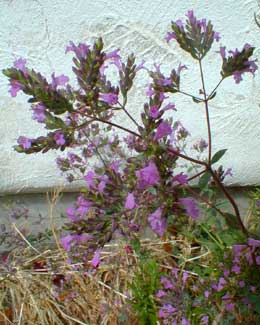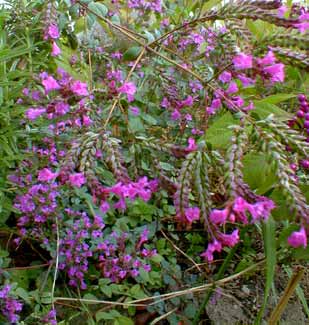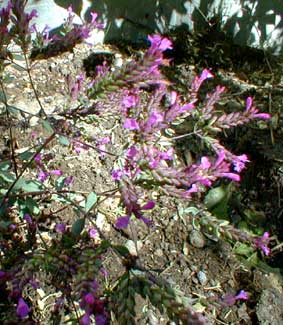
Hopley's Showy Oregano;
or, Purple Marjoram
"You are the daughter of the sea,
oregano's first cousin.
Everything you do is full of flowers,
rich with the earth."
-Pablo Neruda,
1904-1973
1904-1973
 Origanum laevigatum 'Hopley's Purple' likes dry, sandy soil, in full sun. Ours is under the eaves of the house where it gets little water. It has a semi-creeping behavior for its stems of tiny leaves, with a combined upright & leaning habit for the sprays of wee purple blooms, as much as two feet tall, usually a bit shorter, sometimes taller.
Origanum laevigatum 'Hopley's Purple' likes dry, sandy soil, in full sun. Ours is under the eaves of the house where it gets little water. It has a semi-creeping behavior for its stems of tiny leaves, with a combined upright & leaning habit for the sprays of wee purple blooms, as much as two feet tall, usually a bit shorter, sometimes taller.It can look a bit sloppy with this partly upright partly prostrate behavior, & some gardeners may want to stake it up, though I'd recommend crowding it with other xeric herbs so that it doesn't matter if it flops a bit.
The flowers are tiny, but are produced by the thousands on thin stems. They make pleasingly aromatic cut flowers for in the house, & also dry well. It is in general regarded as ornamental, being not flavorful enough to use as a spice, so is commonly called "Garden Oregano" or "Ornamental Oregano." It is even so sufficiently aromatic to add dry leaves to potpourri.
 The leaves like the flowers are also quite small, starting out purplish & aging to sage green, or dark green with bluish sheen.
The leaves like the flowers are also quite small, starting out purplish & aging to sage green, or dark green with bluish sheen.Whenever 'Hopley's Purple' begins to look lanky or untidy, it can be clipped practically to the ground, & will grow back very much renewed. It should also be sheered back either very late in autumn or in winter. It comes back each year as a slightly larger clump of increasing subtle beauty. In areas where winters fall below Five degrees F., it will not perennialize, but can still be grown as an annual.
A single slow-release fertilizing in spring is more than sufficient. Heat-hardy for the xeriscape sun-garden, it vanishes in winter & returns rather late in spring, flowering by June & in full display by July, the blooms persisting until October or until the first hard frost. We've had it still in full flower in November.
It is apt to bloom continuously for summer & much of autumn, sometimes even without sheering, but if there is an interuption in the flowering periodic deadheading or sheering will incite vigorous rebloom. It can be propogated from cuttings, or spring division.
Whenever I'm weeding or working in its area of the garden, I find its spicy scent very appealing & overt, even though it is regarded as one of the less redolent oreganos. Because this native of Turkey & Cyprus is not strongly flavored, it is not regarded as one of the culinary species, unless you're a butterfly, as bees & butterflies regard it as quite appealing.
But all oreganos can be adapted to culinary use if one wishes, & this mainly ornamental species can indeed have its tiny leaves & flowers (but not the woody stems) dried for use as a spice in soups. As the mildest of marjorams, one must not expect a strongly distinct flavor. A sprig not to be eaten makes a nice decorative garnishment just for the scent if lends a plate.
Similarly, marjorams are frequently regarded as of medicinal value, including O. laevigatum, but if the reputed stimulant properties are assumed to be due to the volatile oils, this species has less of these oils than do more powerfully aromatic marjorams.
'Hopley's Purple' is a select cultivar developed at David & Nancy Barker's Hopley's Plants, Ltd., in Hertfordshire, England, the commercial area of the garden having been established primarily to cover the expenses of a very extensive & significant display garden, open to visitors May through October.
We have many oreganos in our gardens including the strictly ornamental O. suendermannii & O. rotundifolium 'Kent Beauty' both of which have large papery purple bracts; O. vulgar 'Variegata' Tricolor Marjoram & O. vulgar 'Humile' dwarf creeping oregano which are both quite tasty, & O. vulgar ssp vulgar 'Dr. Ietswaart' Golden Oregano which has become the one we use the most in the kitchen.